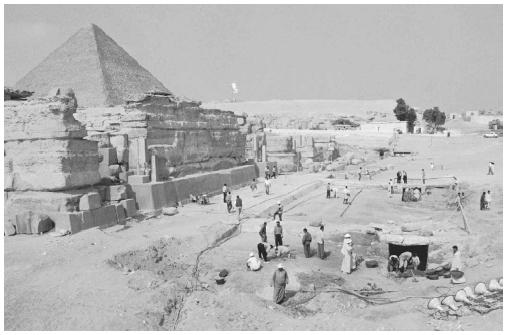Ancient Egypt and the Afterlife
Pyramid texts
The Pyramid Texts recorded some of human-kind's earliest written insights concerning its concepts about the soul and the afterlife. The texts were inscribed on the stone walls of five pyramids at Saccara during the later part of the Old Kingdom, 2400–2240 B.C.E., and were compiled by priestly scholars from a variety of sources, some dating earlier than the beginning of the historical period, about 3000 B.C.E. Beginning with the Middle Kingdom, about 2000 B.C.E., priests began to copy large portions of the Pyramid Texts onto the sarcophagi of pharoahs and nobles.
Although the texts deal only with the manner in which to guarantee the safe passage of deceased nobility to the other world, they also reflect the general thinking of the common people toward the next world, as well as that of the priesthood and the royal heads of state. It is clear that the Egyptians, even during this remote and long-ago period, thought of themselves as being more than a physical body, but what is not easily understood is exactly what their conception of death might have been. From what can be ascertained from the earliest mortuary texts is that the entire culture was in denial of death and refused to accept it as a natural and inevitable event. In fact the texts allude to a time when death did not exist, but there is no account of how death entered the world, as there are in many other cultures.
All pharaohs were considered to be divine, a belief that had its roots in the myths that gods had ruled Egypt in prehistoric times and that the earliest human rulers were the actual children of these divine beings. Therefore, when a pharaoh died, he could be prepared for death and become an "Osiris," the god of resurrection.
The Egyptians of this period conceived of two nonphysical entities, the ka and the ba, that made up the whole self and were of equal value to the physical body. Although it is difficult to ascertain a precise understanding of the cosmology of the Egyptian people of such a faraway time, it would appear that the ka, often represented in hieroglyphs as two arms upstretched in a gesture of protection, was believed to have been a kind of spiritual double of a living person that also served as his or her guardian spirit. A person's tomb was called the het ka, the "house of the ka," suggesting that the Egyptians not only considered the ka an essential aspect of a human being, but understood that a provision for it, as well as for the physical body, must be made at the time of death.
The ba is generally understood by modern scholars as representing that aspect of the essential self that is commonly referred to as the soul. Often depicted in ancient Egyptian art and hieroglyphs as a bird with a human head—male or female, corresponding to the sex of the person represented—the ba hovers near its physical counterpart. In cultures throughout the world, the bird is often utilized as a symbol for the soul. And certainly, in the Egypt of thousands of years ago, the high-flying, free-moving creature of the air would have seemed an obvious representation of the aspect of the self that separates from the body at the time of death.
While there seems no question that the ancient Egyptian view of the nature of each individual human included both the physical and nonphysical aspects of the whole person, the spiritual, nonmaterial representations were not valued above the material body. Such an assertion is easily demonstrated by the lengthy process of embalmment and the elaborate process of mummification conducted on the physical body of the deceased. The magical rituals

User Contributions:
Comment about this article, ask questions, or add new information about this topic:
Ancient Egypt and the Afterlife forum
